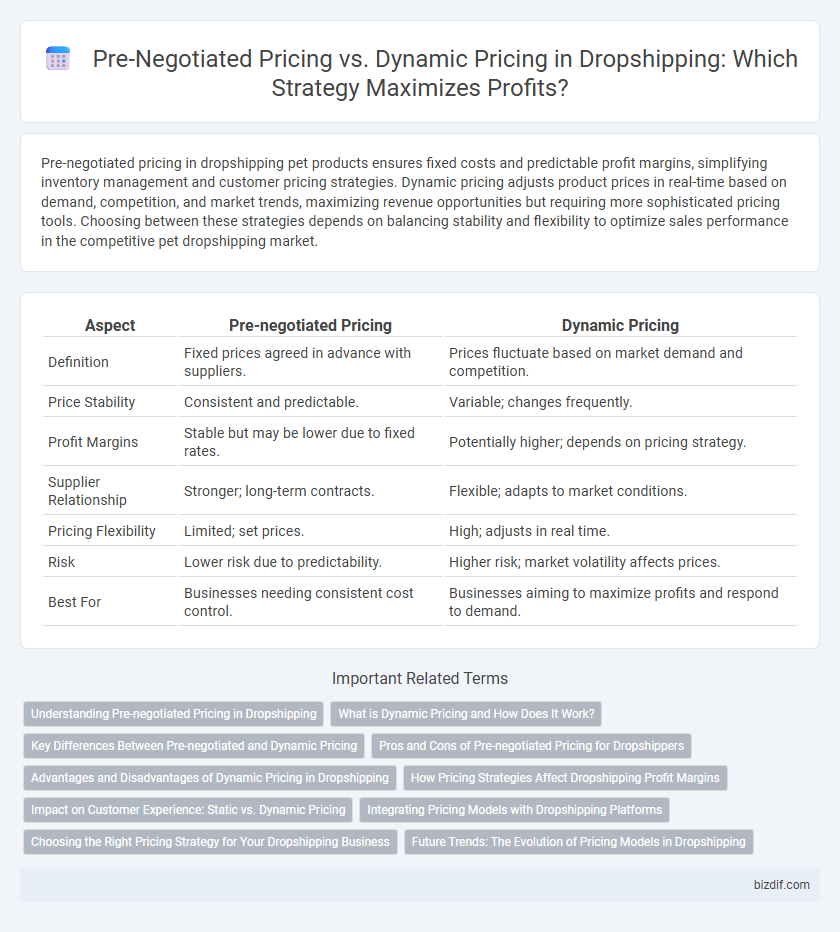Pre-negotiated pricing in dropshipping pet products ensures fixed costs and predictable profit margins, simplifying inventory management and customer pricing strategies. Dynamic pricing adjusts product prices in real-time based on demand, competition, and market trends, maximizing revenue opportunities but requiring more sophisticated pricing tools. Choosing between these strategies depends on balancing stability and flexibility to optimize sales performance in the competitive pet dropshipping market.
Table of Comparison
| Aspect | Pre-negotiated Pricing | Dynamic Pricing |
|---|---|---|
| Definition | Fixed prices agreed in advance with suppliers. | Prices fluctuate based on market demand and competition. |
| Price Stability | Consistent and predictable. | Variable; changes frequently. |
| Profit Margins | Stable but may be lower due to fixed rates. | Potentially higher; depends on pricing strategy. |
| Supplier Relationship | Stronger; long-term contracts. | Flexible; adapts to market conditions. |
| Pricing Flexibility | Limited; set prices. | High; adjusts in real time. |
| Risk | Lower risk due to predictability. | Higher risk; market volatility affects prices. |
| Best For | Businesses needing consistent cost control. | Businesses aiming to maximize profits and respond to demand. |
Understanding Pre-negotiated Pricing in Dropshipping
Pre-negotiated pricing in dropshipping involves setting fixed product costs and margins with suppliers before transactions, ensuring consistent profit margins and simplified inventory management. This pricing strategy reduces unpredictability in expenses, enabling more accurate financial forecasting for online retailers. Dropshippers benefit from streamlined operations and improved supplier relationships by locking in stable prices that do not fluctuate with market demand or competition.
What is Dynamic Pricing and How Does It Work?
Dynamic pricing is a strategy where prices are continuously adjusted based on real-time market demand, competitor pricing, and inventory levels. Algorithms analyze data such as consumer behavior, time of day, and sales trends to optimize pricing for maximum profit and competitiveness. This approach enables dropshippers to respond swiftly to market fluctuations, increasing sales potential and minimizing unsold stock.
Key Differences Between Pre-negotiated and Dynamic Pricing
Pre-negotiated pricing in dropshipping involves setting fixed rates with suppliers before transactions, ensuring consistent cost management and predictable profit margins. Dynamic pricing adjusts product prices in real-time based on market demand, competitor pricing, and inventory levels, allowing for increased competitiveness and maximized revenue. Key differences include price stability with pre-negotiated rates versus flexibility and responsiveness in dynamic pricing strategies.
Pros and Cons of Pre-negotiated Pricing for Dropshippers
Pre-negotiated pricing in dropshipping offers consistent profit margins and simplified financial planning by locking in supplier rates, reducing the risk of price fluctuations. This approach enhances supplier relationships through stable agreements but limits flexibility to adapt to market demand or seasonal trends. Dropshippers may miss out on potential higher profits during peak demand periods due to fixed pricing structures.
Advantages and Disadvantages of Dynamic Pricing in Dropshipping
Dynamic pricing in dropshipping allows sellers to adjust prices in real-time based on market demand, competitor pricing, and inventory levels, enhancing profit margins and responsiveness. However, this strategy can lead to customer distrust due to fluctuating prices and requires sophisticated software and constant market analysis, which may increase operational complexity and costs. While dynamic pricing maximizes revenue potential, it risks alienating customers who prefer stable, predictable pricing typically found in pre-negotiated pricing models.
How Pricing Strategies Affect Dropshipping Profit Margins
Pre-negotiated pricing establishes fixed costs with suppliers, ensuring predictable profit margins and simplifying financial planning for dropshipping businesses. Dynamic pricing adjusts prices in real-time based on demand, competition, and market trends, potentially maximizing revenue but introducing volatility in profit margins. Effective dropshipping strategies balance these pricing models to optimize profitability while maintaining competitiveness in fluctuating markets.
Impact on Customer Experience: Static vs. Dynamic Pricing
Pre-negotiated pricing offers customers consistent and predictable costs, enhancing trust and simplifying the buying process in dropshipping. Dynamic pricing adjusts prices based on real-time factors such as demand, competitor pricing, and inventory levels, which can lead to perceived unfairness or confusion among buyers. Balancing these strategies is crucial, as static pricing boosts loyalty through transparency, while dynamic pricing maximizes profitability but risks undermining customer satisfaction.
Integrating Pricing Models with Dropshipping Platforms
Integrating pre-negotiated pricing with dropshipping platforms ensures stable profit margins by locking in wholesale rates from suppliers, which simplifies inventory management and pricing consistency. Dynamic pricing models leverage real-time market data and competitor analysis to automatically adjust prices, maximizing revenue opportunities and responding swiftly to demand fluctuations. Combining these pricing strategies within advanced dropshipping platforms allows sellers to balance risk and flexibility, optimizing both customer satisfaction and profitability.
Choosing the Right Pricing Strategy for Your Dropshipping Business
Pre-negotiated pricing offers fixed costs and predictable profit margins, ideal for dropshipping businesses seeking stability and simplified inventory management. Dynamic pricing leverages real-time market demand, competitor rates, and consumer behavior to maximize profits but requires advanced data analysis tools and responsive pricing adjustments. Selecting the right pricing strategy hinges on your dropshipping model's scale, target market, and capacity to adapt to pricing fluctuations while maintaining competitive advantage and customer satisfaction.
Future Trends: The Evolution of Pricing Models in Dropshipping
Pre-negotiated pricing in dropshipping offers stable profit margins and predictable supplier costs, while dynamic pricing leverages real-time market data and consumer behavior to optimize revenue. Future trends indicate a shift towards AI-driven dynamic pricing models that enhance pricing accuracy and competitiveness by analyzing vast amounts of data. This evolution enables dropshippers to respond swiftly to market fluctuations and consumer demand, maximizing profitability in an increasingly automated e-commerce environment.
Pre-negotiated Pricing vs Dynamic Pricing Infographic

 bizdif.com
bizdif.com